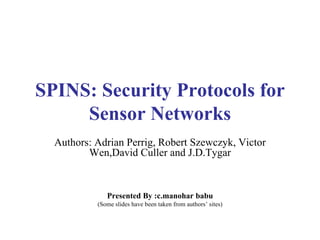015 spins
- 1. SPINS: Security Protocols for Sensor Networks Authors: Adrian Perrig, Robert Szewczyk, Victor Wen,David Culler and J.D.Tygar Presented By :c.manohar babu (Some slides have been taken from authorsâ sites)
- 2. Outline Security for sensor networks - Research Problem Proposed Techniques - SPINS building blocks Applications Related Work Discussion Conclusion
- 3. Sensor Networks are emerging Many applications - Real-time traffic monitoring - Military applications - Emergency and critical systems etc. Need secure communication protocols
- 4. Security for Sensor Networks Data Authentication Data Confidentiality Data Integrity Data Freshness - Weak Freshness - Partial message ordering, no delay information - Useful for sensor measurements - Strong Freshness - Total ordering on req-res pair, delay estimation - Useful for time synchronization
- 5. Challenge: Resource Constraints Limited energy Limited computation(4MHz 8-bit) Limited memory(512 bytes) Limited code size(8 Kbytes) Limited communication(30 byte packets) Energy consuming communication
- 6. Contributions SNEP -Sensor Network Encryption Protocol - Secures point-to-point communication Âĩ°Õ·Ąģ§ģĒīĄ -Micro Timed Efficient Stream Loss-tolerant Authentication -Provides broadcast authentication
- 7. System Assumptions Communication patterns -Node to base station (e.g. sensor readings) - Base station to node (e.g. specific requests) - Base station to all nodes Base Station - Sufficient memory, power - Shares secret key with each node Node -Limited resources, limited trust A B D E F G C Base Station
- 8. Notation A, B Principals( nodes) N A Nonce generated by A C A Counter generated by A Ï AB Master secret key between A and B ( no direction information) K AB Secret encryption key between A and B (depends on direction) Kâ AB Secret MAC key between A and B (depends on direction) {M} KAB Encryption of message M with K AB {M} <KAB,IV> Encryption of message M using key KAB and initialization vector IV MAC(Kâ AB ,M) Message authentication code (MAC) of M
- 9. SNEP Data Confidentiality (Semantic Security ) Data Authentication Replay Protection Weak Freshness Low Communication Overhead
- 10. Key Generation /Setup Nodes and base station share a master key pre-deployment Other keys are bootstrapped from the master key: Encryption key Message Authentication code key Random number generator key Counter RC5 Block Cipher Key Master Key MAC Key Encryption Key random
- 11. Authentication, Confidentiality Without encryption can have only authentication For encrypted messages, the counter is included in the MAC Base station keeps current counter for every node Node A M, MAC(Kâ AB , M) {M} <KAB, CA> , MAC(Kâ AB , C A || {M} <KAB, CA> ) Node B
- 12. Strong Freshness Nonce generated randomly Sender includes Nonce with request Responder include nonce in MAC, but not in reply Node A Request, N A {Response} <KBA, CB) , MAC(Kâ BA , N A || C B || {Response} <KBA, CB> ) Node B
- 13. Counter Exchange Protocol Bootstrapping counter values Node A C A C B , MAC(Kâ BA , C A ||C B ) Node B MAC(Kâ AB , C A ||C B ) To synchronize: A -> B : N A B -> A : C B , MAC (Kâ BA ,N A || C B ).
- 14. Âĩ°Õ·Ąģ§ģĒīĄ : Authenticated Broadcast TESLA : efficient source authentication in multicast for wired networks. Problems with TESLA - Digital Signature for initial packet authentication Âĩ°Õ·Ąģ§ģĒīĄ uses only symmetric mechanism -Overhead of 24 bytes per packet Âĩ°Õ·Ąģ§ģĒīĄ discloses key once per epoch -One way key chain is too big Âĩ°Õ·Ąģ§ģĒīĄ restricts number of authenticated senders
- 15. Key Setup Main idea: One-way key chains K 0 is initial commitment to chain Base station gives K 0 to all nodes K n K n-1 K 1 K 0 X âĶâĶ . F(Kn) F(K1) F(K2)
- 16. ï TESLA Quick Overview I Keys disclosed 2 time intervals after use Receiver knows authentic K3 Authentication of P1:MAC( K5 ,P1) K4 K5 K6 K7 t Time 4 Time 5 Time 6 Time 7 K3 P1 K3 P2 K5 F F Authenticate K5 Verify MAC F K6 F K5
- 17. ï TESLA Quick Overview II Perfect robustness to packet loss K4 K5 K6 K7 t Time 4 Time 5 Time 6 Time 7 K3 P5 K5 P3 K3 P2 K2 P1 K2 Verify MACs P4 K4 F F Authenticate K5
- 18. ï TESLA Properties Asymmetry from delayed key disclosure Self-authenticating keys Requires loose time synchronization Low overhead (1 MAC) - Communication (same as SNEP) - Computation (~ 2 MAC computations) Independent of number of receivers
- 19. Applications Authenticated Routing Node to Node Agreement A B: N A , A B S: N A ,N B , A, B, MAC(Kâ BS , N A || N B || A || B) S A: {SK AB } KSA , MAC(Kâ SA ,N A || A || {SK AB }K SA ) S B: {SK AB } KSB , MAC(Kâ SB ,N B || B || {SK AB }K SB )
- 20. Related Work in Broadcast Authentication Symmetric schemes - Link-state routing updates - Multi-MAC Asymmetric schemes - Merkle hash tree Chained hashes - EMSS Hybrid schemes -Stream signature -K-times signature
- 21. Discussion: Drawbacks The ï TESLA protocol lacks scalability - require initial key commitment with each nodes, which is very communication intensive SPINS uses source routing, so vulnerable to traffic analysis
- 22. Discussion: Risks Un-addressed Information leakage through covert channels No mechanism to determine and deal with compromised nodes. Denial of service attacks No Non-repudiation
- 23. Conclusion Strong security protocols affordable - First broadcast authentication Low security overhead - Computation, memory, communication Apply to future sensor networks -Energy limitations persist -Tendency to use minimal hardware Base protocol for more sophisticated security services






















